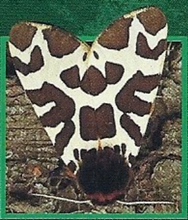These extreme survivors have evolved clever ways to avoid becoming a meal. As larvae, tiger moths eat poisonous plants to fill their bodies with the toxins; adult moths retain the poison, which gives them a bad taste and keeps predators away. Some of these clever creatures can jam the radar signals of attacking bats, and one tiger moth species can scare away enemies with foaming glands behind its head that let out a loud snap, crackle and pop!
Warning Flash: A tiger moth's outer pair of wings are usually patterned with the bark of trees. If a predator sees through this disguise, the moth flashes a pair of brightly-colored wings underneath to startle its enemy, giving the insect time to escape.
Toxic Shock: Tiger moth caterpillars are covered with prickly hairs that deter most enemies, such as birds. These larvae also spend a lot of time munching on poisonous plants, such as ragwort and foxgloves. Toxins from these plants keep the moths poisonous for life.
Fizz Off[]

Tiger moth's [sic] come in a variety of patterns.
Poisonous body fluids and bright warning colors are enough to keep most predators away from tiger moths, but one species takes its defenses to the next level. Known as the frothing tiger moth, this insect has special glands behind its head that secrete a green, bubbly foam that fizzes loudly, like a bottle of soda. This spectacle frightens would-be attackers into retreat, plus it tastes terrible. Afterward, the tiger moth extends its curly feeding tube and drinks the foam so it can use it again when another enemy tries to attack.
Radar Jam: Tiger moths have special, drum-like organs called tymbals that allow them to hear the high-pitched squeals of bats looking for food. Some species can emit clicking noises that confuse a bat's targeting system and throw them off-course.
Under Cover: There are about 11,000 species of tiger moth. Most of them are active at night, when most of their enemies are resting (except bats), so they can feed on plants in peace.
Foaming at the Ears[]
- As a bat flies through a forest at night, its "radar" signals pick up a moving object. Thinking it might be a juicy insect, the bat swings in. The tiger moth picks up the bat's squeals and flies off, but the bat follows.
- Without warning, bubbles of sizzling foam burst from behind the frothing tiger moth's head. Frightened, confused, and unwilling to swallow the brightly-colored fluid, the bat veers off to the side and gives up its pursuit.
Trivia[]
- The tiger moth is one of two moths included in the series to be illustrated in their adult stage. The other is Death's Head Hawk Moth.
- It is the only moth to not show their caterpillar stage in any form on their knowledge card.
- The Creature Features section lists it's diet under "Prey", despite it only being listed eating plant products.
- The caption of the photo on the back of the knowledge card says "moth's" instead of "moths".
